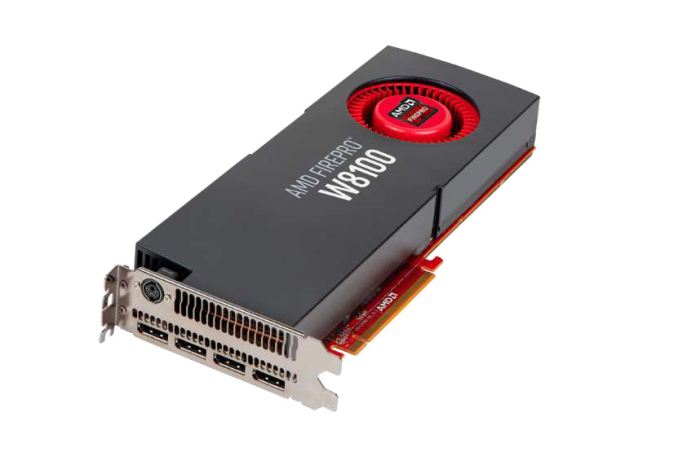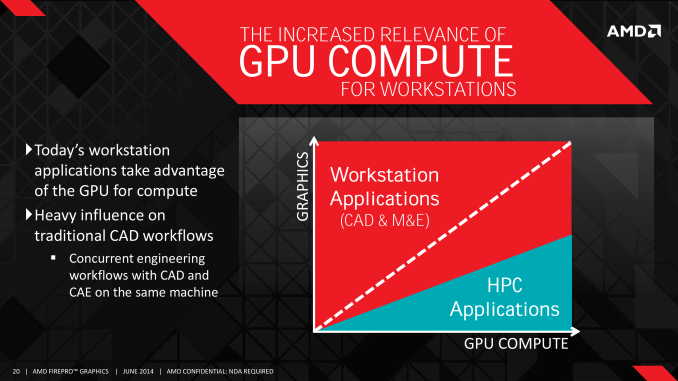AMD Announces FirePro W8100
by Ryan Smith on June 23, 2014 8:00 AM EST
Following up a little less than 3 months after the launch of their new flagship professional graphics card, the FirePro W9100, AMD is back once again this week to further flesh out the FirePro Wx100 series. This time around AMD is announcing a lower tier counterpart to the W9100: the W8100.
Like the W9100 earlier this year, the W8100 is designed to be a follow-up to AMD’s existing Tahiti based FirePro products, in this case the FirePro W8000. Based on a pared down version of AMD’s Hawaii GPU – making this the obligatory second-tier part – the W8100 is intended to refresh AMD’s professional lineup by improving performance while also improving AMD’s feature set through the power and capabilities of the company’s Hawaii GPU.
| AMD FirePro W Series Specification Comparison | ||||||
| AMD FirePro W9100 | AMD FirePro W8100 | AMD FirePro W9000 | AMD FirePro W8000 | |||
| Stream Processors | 2816 | 2560 | 2048 | 1792 | ||
| Texture Units | 176 | 160 | 128 | 112 | ||
| ROPs | 64 | 64 | 32 | 32 | ||
| Core Clock | 930MHz | 824MHz | 975MHz | 900MHz | ||
| Memory Clock | 5GHz GDDR5 | 5GHz GDDR5 | 5.5GHz GDDR5 | 5.5GHz GDDR5 | ||
| Memory Bus Width | 512-bit | 512-bit | 384-bit | 256-bit | ||
| VRAM | 16GB | 8GB | 6GB | 4GB | ||
| Double Precision | 1/2 | 1/2 | 1/4 | 1/4 | ||
| Transistor Count | 6.2B | 6.2B | 4.31B | 4.31B | ||
| TDP | 275W | 220W | 274W | 189W | ||
| Manufacturing Process | TSMC 28nm | TSMC 28nm | TSMC 28nm | TSMC 28nm | ||
| Architecture | GCN 1.1 | GCN 1.1 | GCN 1.0 | GCN 1.0 | ||
| Warranty | 3-Year | 3-Year | 3-Year | 3-Year | ||
| Launch Price (List) | $3999 | $2499 | $3999 | $1599 | ||
All-told, next to the W9100 the W8100 is a slower, less power hungry, and otherwise more affordable alternative to AMD’s flagship FirePro. This Hawaii configuration is very similar to AMD’s desktop Radeon R9 290, utilizing a 40 CU design (4 CUs disabled) to offer 2560 stream processors and 160 texture units. Meanwhile the ROP and memory bus remain untouched will the full 64 ROP plus 512-bit (320GB/sec) memory bus configuration active; however the W8100 is outfit with 8GB of GDDR5 versus the W9100’s more extreme 16GB.
Clockspeeds are down from the W9100, dropping from 930MHz to 824MHz. Between the clockspeed reduction and the reduction in stream processors, this puts theoretical compute performance at 4.2 TFLOPS single precision or 2.1 TFLOPS double precision, with W8100 retaining Hawaii’s native ½ rate double precision execution speed. These reductions have also brought power usage down from W9100’s 275W to just 220W, allowing W8100 to be used in more constrained workstations that can only handle a 225W (6pin + 6pin) video card. Ultimately compared to the older W8000, the W8100 ends up consuming around 31W more power, but it also significantly improves over W8000’s performance, especially in memory bandwidth constrained scenarios and in double precision operations (where theoretical performance has more than doubled).
Moving on, physically the W8100 is very similar to the W9100. However here we see AMD drop the 6 mini-DisplayPorts for 4 full sized DisplayPorts. This is mostly for product differentiation, with W8100 topping out at 4 4K displays while W9100 can handle 6. The switch from mini-DisplayPort to DisplayPort however is consistent with AMD’s position of using DisplayPort whenever possible, reserving mini-DisplayPort only for use in setups where the larger DisplayPort cannot fit.
As with the W9100, AMD is strongly targeting the mixed graphics/compute workload market with the W8100, banking on the Hawaii GPU’s ability to efficiently handle both tasks. This includes a strong emphasis on CAD and CAE, along with GPU compute-accelerated media creation and processing. To that end the W8100 will also be a part of AMD’s Ultra Workstation initiative, allowing either W8100s or W9100s to be used in Ultra Workstation branded machines.
AMD’s principle competition for the W8100 will be NVIDIA’s Quadro K5000, and to some lesser extent the K5000 + Tesla K20 Maximus configuration. K5000 is based on NVIDIA’s GK104, and on its own is a capable graphics card but lacks the kind of compute performance that GK110 products such as Tesla K20 can provide. Consequently AMD is pitching W8100 as an alternative to NVIDIA’s ecosystem, offering strong compute and graphics performance in a single card, and at a lower price than a comparable Maximus setup.
Finally, given their intention to directly compete with the K5000 AMD will be pricing W8100 similarly, which would put the list price at $2499 and retail prices at around $2000. AMD tells us that W8100 cards are already shipping to channel partners now, and should be available in the channel in the middle of July.












5 Comments
View All Comments
Galcobar - Monday, June 23, 2014 - link
First page, second paragraph, second sentence: "Based on a pared down version of AMD’s Hawaii GPU – making this the obligatory second-tier part – the W8000"Think that's supposed to be referencing the new card, the W8100
dylan522p - Tuesday, June 24, 2014 - link
Still doesn't have Cuda so worthless to a lot of people.m0du1us - Friday, July 25, 2014 - link
@dylan522p This is for workstation graphics, like running AutoCAD 3d Studio Max, Maya, SolidWorks. If you wanted to run software off the GPU, get a Tesla or GRID from Nvidia, you know, the GPU's you can't plug a screen into?DrApop - Tuesday, June 24, 2014 - link
Won't render Blender and won't render Premiere Pro v6. Not any use to me....even if it were $10 bucks.Alexvrb - Wednesday, June 25, 2014 - link
Eventually Blender's OpenCL implementation will work on AMD hardware. Luxrender works quite well from what I have heard. Also doesn't the latest Premiere Pro support OpenCL better than older versions?